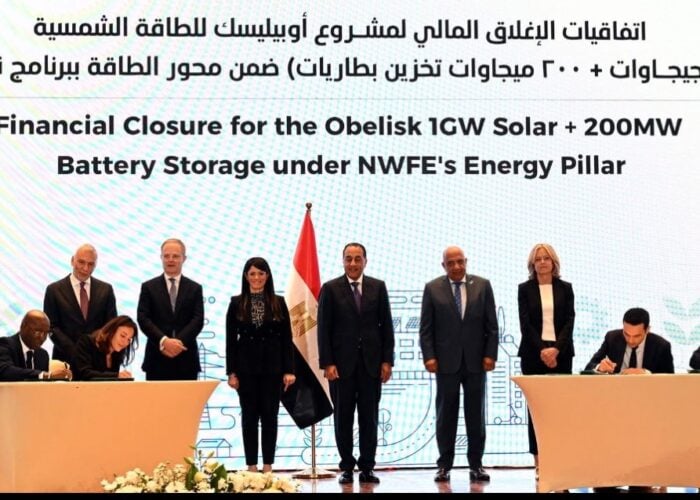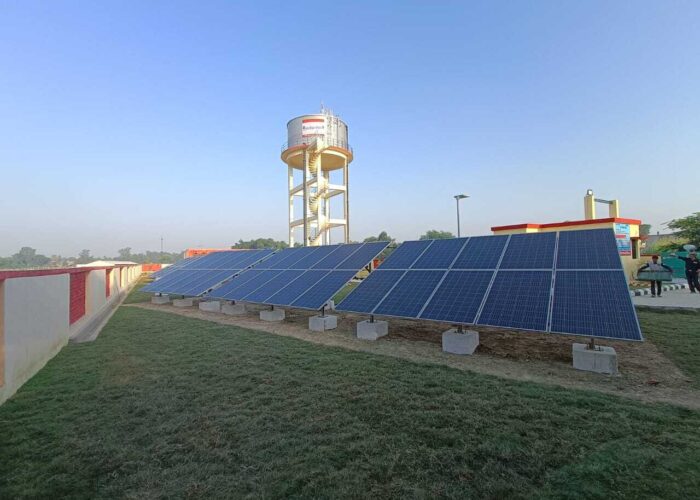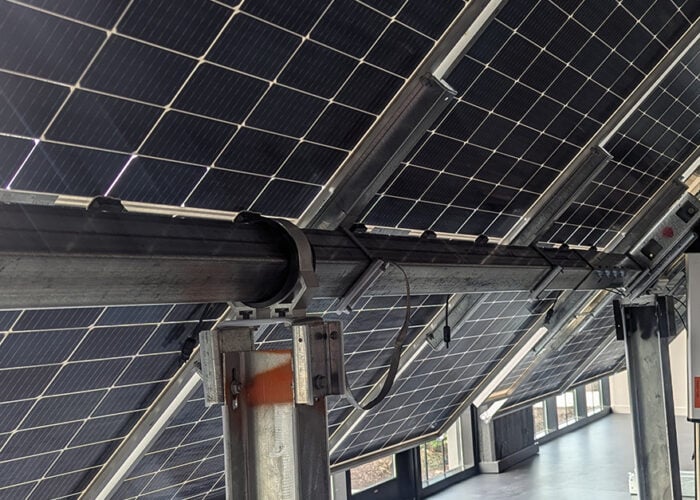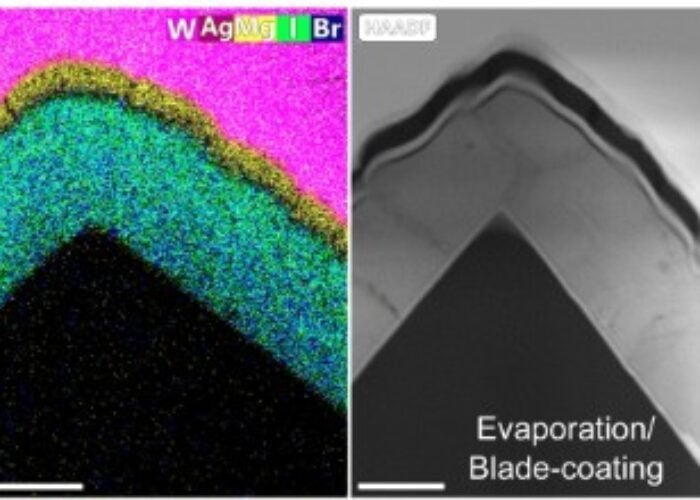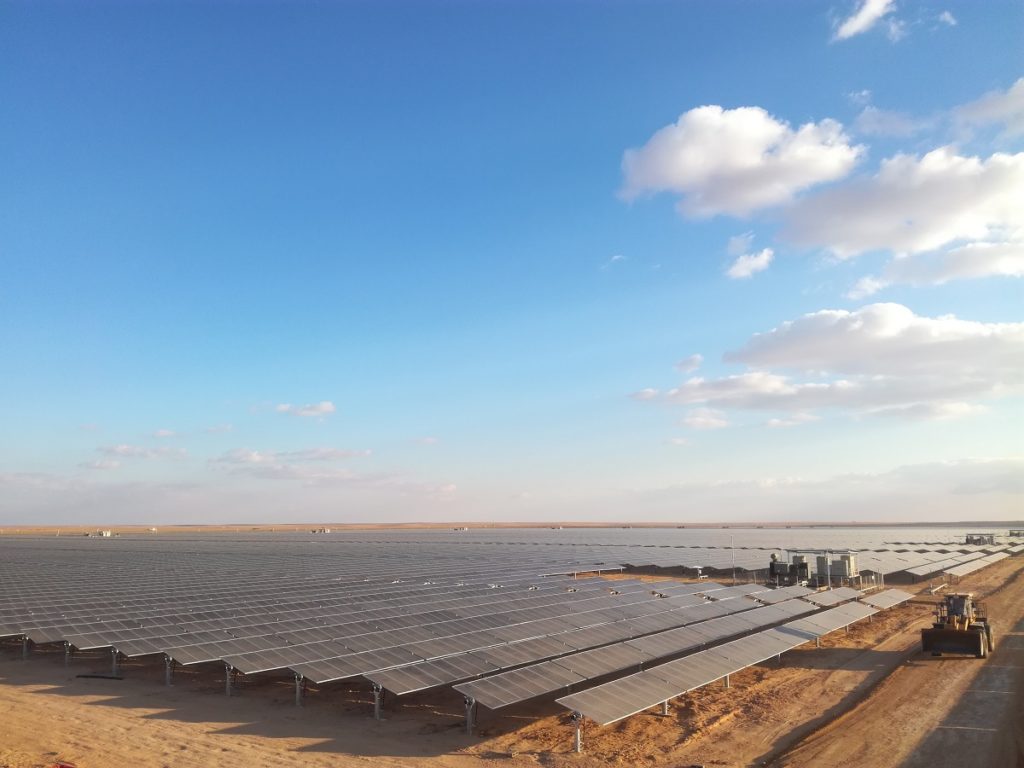
Solar PV has taken off in the MENA region in recent years, driven by positive governmental policy, prominent tenders and decarbonisation targets. But challenges remain, both for smaller companies wishing to enter the market and in the operation of plants. Molly Lempriere takes a look at the market drivers and the challenges of competing.
Despite a slow start, the development of solar in the Middle East and North Africa (MENA) is picking up pace, as countries commit to decarbonisation targets. Should all of the renewables targets in the region be met for example, there will be 80GW of renewable capacity by 2030 according to the International Renewable Energy Agency, in excess of 50GW of which is expected to be solar PV.
Unlock unlimited access for 12 whole months of distinctive global analysis
Photovoltaics International is now included.
- Regular insight and analysis of the industry’s biggest developments
- In-depth interviews with the industry’s leading figures
- Unlimited digital access to the PV Tech Power journal catalogue
- Unlimited digital access to the Photovoltaics International journal catalogue
- Access to more than 1,000 technical papers
- Discounts on Solar Media’s portfolio of events, in-person and virtual
The falling price of solar has been instrumental to this, along with the availability of cheap and sunny desert land, large projects being able to benefit from economies of scale and an increasing number of tenders. As such, even once hesitant oil and gas-rich nations have begun to commit to large solar PV projects.
Countries such as Saudi Arabia, Egypt and the United Arab Emirates (UAE) have been leading the way and have continued to commission large projects, while Oman, Kuwait and Tunisia all have growing project pipelines, and countries like Pakistan and Iraq are engaging in their first utility-scale projects.
The value of operational solar projects in the MENA region is now estimated between at US$5 billion and US$7.5 billion according to market research group Frost and Sullivan. The total value of projects expected to come online by 2024 is between US$15 billion and US$20 billion, highlighting the increasing growth in the region.
The Middle East’s giants
Within the largest economies in the MENA region, an increasing number of very large-scale solar projects have been emerging, with the UAE, Saudi Arabia, Egypt and Qatar leaders in this push.
The efforts of the authorities in Dubai and Abu Dhabi have helped the UAE become a frontrunner in the deployment of solar PV for example. In October 2021, the nation unveiled a plan for becoming net-zero emissions by 2050 – the first country in the MENA region to do so – which includes a goal of 50% clean energy.
Hamid Can Baş, consultant at Apricum – The Cleantech Advisory, suggests that the market may slow down after 2022, as the completion of large projects will bring the country close to its 2030 targets. The market size will likely be determined by whether other nations beyond Dubai and Abu Dhabi follow suit and announce tenders.
Another giant is the Kingdom of Saudi Arabia, which is targeting 27.3GW of renewables – weighted heavily towards solar at around 20GW – by 2023, and 58.7GW by 2030. The country’s Renewable Energy Project Development Office (REPDO) ran an initial two tenders, one for solar and one for wind in 2017. The 300MW Sakaka solar project from state-owned developer ACWA Power won a year later, with a winning bid of US$0.0236/kWh, which at the time was a world record.
The completion of REPDO rounds two and three, along with other bilateral agreements for large scale solar projects “paints a bright picture for the future”, adds Can Baş. The localisation requirements within these auctions additionally signal the “development not only in PV plant installations but also an emerging PV industry”.
The Sakaka solar project’s tariff record has been broken a number of times since the auction however, including by Qatar’s first solar tender which saw a price of just US$0.01747/kWh. The resultant 800MW Al Kharsaah Solar PV IPP Project is being developed by a consortium of French energy giant Total (49%) and Japanese conglomerate Marubeni (51%).
Beyond the PV heavyweights, other MENA countries are beginning to bring in decarbonisation target and tendering to build out solar. Algeria for example updated its Renewable Energy and Energy Efficiency Development Plan in 2019 to target 5.6GW of solar PV by 2030. In 2019, the nation had around 343MW of renewables, the bulk of which is made up of solar PV according to the Middle East Solar Industry Association (MESIA).
Across North Africa in general, there has been steady growth in recent years with renewable energy production growing by 40% over the last decade. This meant 4.5GW of wind, solar PV and solar thermal capacity were added to its renewable power fleet. The region’s renewable generation capacity grew by 80% over the same period and by almost 560% if you exclude hydropower.
Much of this has been driven by policy, laws and regulations. Egypt, for example, introduced feed-in-tariffs in 2014, which was followed up by allowing long-term power purchasing agreements in 2017, making it more attractive to independent power producers. The impact of these changes can be seen in the development of the 1.8GW Benban solar park.
Transparency and the growth of markets
While there has undoubtedly been significant progress made in the region, encouraged by cheap project financing and supportive tax regimes, a number of key challenges remain. Some of these are due to the shape of the market currently as thus far it has been dominated by large-scale, government run tenders, and “the absence of other opportunities such as participation in merchant electricity markets [has] made the market development solely reliant on PV auctions,” says Can Baş.
Within this, there is a lack of transparency in most parts of the region in terms of the bidding process, says Ibtihal Abdelmotteleb, solar analyst at Wood Mackenzie, making identifying the true cost all the more challenging.
“A lot of the numbers they report, they’re completely hypothetical, they’re not really what the project is being paid,” Jenny Chase, head of Solar Analysis at BloombergNEF says. “And usually [the state’s] utility is owning the project. So there’s also a bit of confusion over what that represents, and they’re not very transparent about it.”
The record low prices seen in the region – whether they’re as low as stated or not – are a significant challenge to smaller players in the market, as they simply cannot compete within an auction setting. As such, the market has been dominated by energy majors and state-owned entities like Saudi Arabia’s AWCA, Abu Dhabi’s Masdar, Dubai Electricity and Water Authority (DEWA) and Qatar’s Siraj Energy.
While a feature of the MENA region currently, this prevalence of government backed companies is not a unique trait says Heymi Bahar, senior analyst for Renewable Energy Markets and Policy at the IEA, and more representative of an industry in its early stages.
“In some of the places, there have been preferential land allocation and preferred grid connection, which may or may not be included in the bids, we don’t know,” he says. “But I think it’s important to understand that it’s driven by the policies, and in the initial phases of this deployment, these policies are key.”
This prevalence of government companies and financing has so far helped to achieve low costs, and is a trend we’ve seen in other regions such as China and India, Bahar says.
“Profit margins of PV projects in the region are razor thin as a result of very competitive auction process”
These low costs will be further challenged by rising technology prices, with Chase suggesting the amount of solar built in the next year could potentially slip and the record low auction rounds seen in recent years will likely drop off in the short term. Can Baş agrees, saying it will take two to three years before module prices drop to 2020 levels following the recent rises in polysilicon, steel and shipping costs.
“Profit margins of PV projects in the region are razor thin as a result of very competitive auction process,” he says. “Any increase in component prices can disrupt the finances of the project. Developers who have the luxury to postpone their projects opted to do so with the hopes of relaxing prices next year.”
As such, companies that have the ability to postpone their projects are likely to do so, while those with a close deadline or a backlog of project will need to “take the hit” he says, and deliver with even lower margins or at a loss.
Given the strong role of government on the development of solar currently, the impact of the fluctuations in the value of oil is likely to also challenge the rollout of projects. In particular in countries like Kuwait, Iraq or Algeria, lower oil prices could reduce the appetite of government to pursue renewables.
Broadening the markets margins
There are a number of actions that could be taken to develop these markets further, including holding more frequent auctions that would help market players maintain a healthier project pipeline. This would additionally help to increase visibility in the market, which in itself would increase investment appetite.
Subsidy reform that ended the artificially low fossil fuel prices in the region, would help cost-effective solar tariffs, which ultimately would lead to bill savings through solar says Abdelmotteleb. Additional steps that could be taken include promoting competitive local markets, a knowledgeable customer base and Opex savings.
“With the support of government initiatives, local developers [could] play a role in promoting the perception of the energy transition in the Middle East,” she continues. “Flexible business models and a clear understanding of Opex savings will further drive consumer enthusiasm and C&I installations.”
Beyond the large scale project, rooftop solar poses a opportunity for smaller develops and start-ups, which could help broaden the solar market as a whole in the region. For example, the Sahim program in Oman, which provides an export tariff for excess generation from rooftop solar PV fed into the grid, or Shams Dubai, a rooftop solar program brought in 2015 that allows net metering ensuring consumers are paid for surplus generation which is fed to the grid, have both seen some success.
“Besides state-owned developers, currently the C&I sector is developing strongly,” adds Abdelmotteleb. “Local developers are playing a main role in the market for different C&I offtakers such as retailers, schools, universities, factories, agriculture sector, as well as the mining sector.”
Operational challenges
Once the projects are developed, there remains operational challenges to be considered, including the impact of soiling on operational solar farms, with the conditions of much of the desert landscape leading to a build-up of dust on panels and other equipment. Dr Ben Figgis, research program manager at the Qatar Environment & Energy Research Institute (QEERI), says in Qatar they see a reduction in generation of around half a percent a day due to soiling. Therefore without cleaning, power generation can fall by roughly 15% over a month, depending on the time of year.
“That’s a critical challenge that needs to be dealt with,” he adds. “I think there’s a lot of technologies that are being developed and there is space for a lot of innovation.”
It remains a fairly nascent area of technology development, with the majority of focus falling on automated cleaning robots. Beyond the panels themselves – with bifacial mono PERC modules emerging as the dominant technology in the region – the impact of soiling on other components must also be considered.
The MENA region covers over 15 million square kilometres, and includes a multitude of different environments. Dr. Veronica Bermudez senior research director of the Energy Center at QEERI notes that not all deserts are the same, so while many in the region are very dry, there are also humid desert regions adjacent to coast, which results in conditions featuring high salinity.
The type of dust in the atmosphere varies therefore, with the Sahara typified by fine dust, says Chase. “So unlike, say, the Atacama Desert in Chile, you’ve got a lot of soiling, and often dust in the atmosphere reducing the energy going in,” she adds. “So although it is pretty sunny, it’s not actually as sunny as you might have thought.”
Growing targets and growing solar
Despite the challenges, further growth is expected across the region in the coming years, in particular given the ever increasing solar, renewable and decarbonisation targets announced.
This includes giants like the UAE publishing its UAE Net Zero by 2050 Strategic Initiative in October 2021, which includes a target of 14GW of carbon-free energy by 2030. But also smaller markets, such as Israel targeting 30% of electricity production from solar energy by 2030, Morocco is aiming for 52% renewable energy by 2030 and Oman has set a target to derive 20% of electricity from renewables by 2027 in its National Energy Strategy.
“I think North African countries will continue to build substantial amounts of solar because they often have quite serious power issues. And I think probably they will continue to be big contracts with the big companies in the richer countries,” says Chase.
Chase says that in the MENA region more broadly, she expects “a bit of sense coming into the region and the realisation that we can just build a couple of gigawatts every year and it doesn’t have to be a big drama” as countries move away from reputational competition as capex jumps in the short term due to module prices.
The appeal of a green gas: solar powered hydrogen in MENA
An emerging technology gaining attention in the MENA region is green hydrogen, which could offer an option for the storage of surplus renewable generation, aid balancing supply and demand, and as a multipurpose energy vector, offer a potential route for decarbonising harder to abate sectors.
The Middle East in particular has significant green hydrogen potential, with research from Wood Mackenzie finding that almost 60% of proposed green hydrogen export projects are located in the Middle East and Australia. These are principally targeting markets in Europe and Northeast Asia.
“In addition to investing in renewables to slash emissions and enhance energy security, countries and industries are now looking to electricity-based fuels and feedstocks, and hydrogen could be the gamechanger,” said Wood Mackenzie research director Prakash Sharma in a report. “A key differentiator is hydrogen’s massive potential in traded energy markets. Low-carbon hydrogen and its derivatives could account for around a third of the seaborne energy trade in a net zero 2050 world.”
The first green hydrogen project in the MENA region was inaugurated in May 2021 by Sheikh Ahmed bin Saeed Al Maktoum, chairman of the Dubai Supreme Council of Energy and chairman of the Expo 2020 Dubai Higher Committee. The Mohammed bin Rashid Al Maktoum Solar Park in Dubai will work as a demonstrator plant for the potential of green hydrogen, along with a number of other technologies on the site including battery energy storage.
Mohammed bin Rashid Al Maktoum Solar Park includes 1GW of solar powered hydrogen capacity, built with the support of German industrial conglomerate Siemens. The solar park has two operational solar plants currently – the 13MW Phase 1 plant and the 200MW Phase II plant – and a further 800MW of PV capacity is under development.
It will support the Dubai Clean Energy Strategy 2050 according to DEWA, with the emirate aiming for 75% of its total power capacity to come from clean energy sources by 2050.
At the inauguration of the hydrogen project, Dr Sultan bin Ahmad Sultan Al Jaber, minister for state for the UAE, said being an early adopter of a hydrogen economy will be instrumental in achieving sustainable economic growth in the country.
“The Green Hydrogen Project represents a major step forward in this direction and will greatly accelerate our production of renewable and clean energy sources and contribute to our on-going climate action efforts.”
Beyond the Mohammed bin Rashid Al Maktoum Solar Park, a joint venture made up of Air Products, ACWA Power and NEOM is developing a US$5 billion hydrogen project in Saudi Arabia. NEOM Green Hydrogen will include a 1.2 million tonne a year green ammonia plant, with more than 4GW of solar, wind and storage powering the electrolyser onsite when production begins in 2025.
The largest green hydrogen plant in the world meanwhile is set to be built in Oman, where 25GW of wind and solar will be used which the plant in Al Wusta governorate on the Arabian Sea is completed in 2038.



